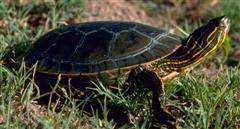Painted Turtle - Western
Scientific Name: Chrysemys picta bellii
Thu, 21st November, 2024 - 5:00 pm GMT
Sponsor Ads:

Alternative Name
Scientific Name: Chrysemys picta belliiBasic Info
The Western Painted Turtle is the largest subspecies of all Painted Turtles. They often grow to lengths of 7 inches and have been known to reach almost 10. Their carapace is smooth, flat, and oval in shape. It is green and black in color, sometimes with red markings. The plastron is yellow with a tinge of red and there is a reddish brown shape that varies on top of this. The skin of the Western Painted Turtle is olive or black with yellow and red stripes on their necks, legs, and tails, and they have yellow stripes on their heads. The females are larger than the males, but the males have longer foreclaws and tails. All Western Painted Turtles have webbed feet for swimming.
Health
The Western Painted Turtle is semi aquatic, so provide it with a setup in which it can easily crawl onto the land portion from the water portion. Two of these turtles can be housed in a 55 gallon aquarium. A filter is recommended to help maintain water quality. They should be exposed to full spectrum UV lighting for about 13 hours a day. The Western Painted Turtle is omnivorous and will eat a large amount of vegetation and invertebrates. Freshwater fish, trout chow, carp pellets, and floating turtle food sticks are common foods offered in captivity. Feeding these turtles in a separate tank will help to keep their water clean. Breeding In a courtship ritual, the male Western Painted Turtle will swim around and position himself in front of the female. He will then stroke her head with his long claws. If the female accepts him she will stroke his forelimbs with her own claws. After mating, the female will dig a nest 4 to 6 inches deep in a sandy area near water. She will lay 2 to 20 eggs per clutch, and she can be expected to lay 2 or 3 clutches a year. Sex of the hatchlings is determined by temperature. Eggs incubated at 87 degrees Fahrenheit will produce females and eggs incubated at 77 degrees will produce males. At temperatures between these ranges, both males and females will hatch. After about 75 days, the eggs will hatch and the hatchlings will move towards water. They will reach maturity around 5 years of age and can live as many as 20 years if they are properly maintained.Habitat
Found all over North America from the southern parts of Canada to the northern parts of MexicoBehavior
The Western Painted Turtle is one of the most active, colorful, and comical of all turtles that a pet owner could want. The Western Painted Turtle can do well as a first time turtle owner pet. They are extremely hardy and they are easy to keep in groups. They can be kept with other Painted Turtles and do not have to be kept with their subspecies alone. In fact, it is not rare to find hybrid hatchlings within this species. The Western Painted Turtle may be shy when it comes to being held, but they can become accostomed to it when handled regularly. They are semi-aquatic, so you will need to be able to provide them with a land and pool area.Origin
North AmericaHistory
The Western Painted Turtle is found all over North America from the southern parts of Canada to the northern parts of Mexico. These places include Ontario, British Columbia, Oklahoma, Missouri, Oregon, Texas, Colorado, Wyoming, Idaho, New Mexico, Arizona, Utah, and Chihuahua, Mexico. Here they inhabit ponds, marshes, and lakes that have slow moving water. Females have a very strong need to move to mating grounds where they were born.Common Foods
N/ASponsor Ads:
"It is our choice of good or evil that determines our character, not our opinion about good or evil." -- Aristotle. Nicomachean Ethics.
Painted Turtle - Western
Coded by: BGID® | ALL RIGHTS RESERVED Copyright © 2000-2024
Disclaimer | Privacy | Report Errors / Contact | Credits
















